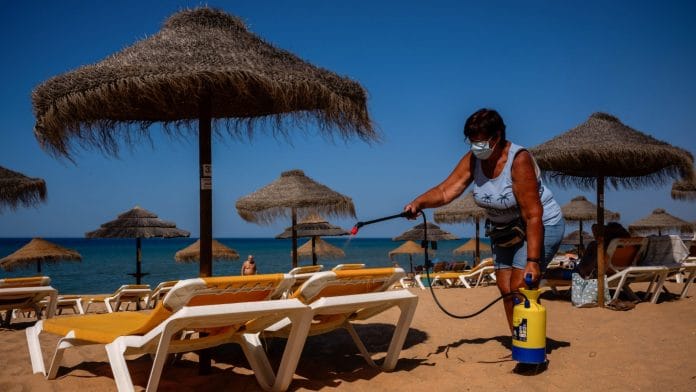For people stuck at home tending their stockpiles of face masks and toilet paper, it’s hard to think of a simpler pleasure than the prospect of heading on holiday to some sun-kissed beach.
Travel bubbles — the limited openings of international borders as coronavirus transmission weakens in some parts of the world — are starting to spring up. The European Union lifted restrictions on movement within its passport-free Schengen Zone last month, causing cross-border flights to quadruple in frequency. Singapore has been allowing some business travel from six Chinese provinces since last month, and is looking to set up a similar arrangement with Malaysia. Now Deutsche Lufthansa AG, United Airlines Holdings Inc., IAG SA and American Airlines Group Inc. are seeking a U.S.-European Union virus-testing program to allow trans-Atlantic trips to resume as well.
While an increasing number of tourists may be willing to chance their health for the sake of a long-overdue break, the decision for governments contemplating this is far more complex — even setting aside the most obvious risk that increased border crossings could help the spread of the coronavirus.
That’s because, in most countries, international tourism is dwarfed by the scale of domestic travel, as my colleague Clara Ferreira Marques has written about Vietnam. It’s also because nations run the gamut from those whose residents spend more overseas than foreigners do on inbound trips (such as China, Canada and the U.K.) to those for which tourism is a major net export, such as the U.S., Thailand and Spain.
When economies are cratering and unemployment is soaring, that imbalance may become an important factor in deciding what to do.
Take New Zealand and Australia, which, before a recent outbreak in Melbourne, appeared to have more or less stamped out Covid-19 and were heading toward opening a bubble. For New Zealand, it’s a no-brainer. International tourism is the country’s largest export sector and accounts for 8.4% of employment, with Australians making up 40% of visitor arrivals, as James McIntyre of Bloomberg Economics wrote in a recent note.
For Australia the calculus is a lot harder. Unlike New Zealand, the country is a net importer of tourism — in other words, Australians spend more money abroad than foreigners spend in Australia. Last year, overseas expenditures exceeded receipts to the tune of about A$19 billion ($14 billion), equivalent to about 1% of gross domestic product. The more that revenue gets trapped at home and spent on domestic hotels, restaurants and visitor attractions, the easier it will be for the economy and job market to recover from a historic slump.
Those complicated distributional impacts happen within economies as well as between them. For instance, the airline sector is likely to benefit most from an increase in international travel. These companies have vast outlays on twin-aisle planes and flight crews that will be mostly out of action until long-haul trips resume. But in most countries, airlines — and particularly their international arms — constitute a relatively small slice of tourism employment, and one that’s already relatively well-protected in terms of pay and employment rights.
In the U.S., the hotels and lodging sector employed about four times as many people as airlines did before coronavirus hit — and the 48% slump in employment as infection spread between March and May represented about 7.5 jobs lost for every one in aviation. Airlines tend to be heavily unionized and often boast government stakes in airports and carriers, making politicians more disposed to pleas for support. Singapore is a net importer of tourism and employs far more people in ground-based services than in aviation, but don’t be surprised if the government’s control of Singapore Airlines Ltd. and Changi Airport pushes the city-state to open up sooner rather than later.
Beyond that, there’s even a diplomatic angle. Small island states such as those in the Caribbean and Pacific and Indian Oceans are some of the most tourism-dependent countries on the planet, and risk devastation if border lockdowns continue much longer. Major sources of holidaymakers like the U.S., U.K., China, Japan, Australia and Taiwan could buy immense goodwill by allowing their residents to visit at an early stage. Such small island states account for about a fifth of United Nations member countries. As we’ve seen in areas from whaling to recognition of Taiwan, cultivating their favor is a popular avenue of geopolitical competition.
Those complexities probably explain the relatively slow progress in turning travel bubbles from proposals into reality. Right now, tourist dollars are a precious resource that stricken economies would like to see spent at home. Your dream of a getaway as summer turns to winter may have to wait until the pandemic has passed. – Bloomberg
Also read: Saudi Arabia, Russia, UK, Germany hope to ‘wow’ citizens with Covid staycations






